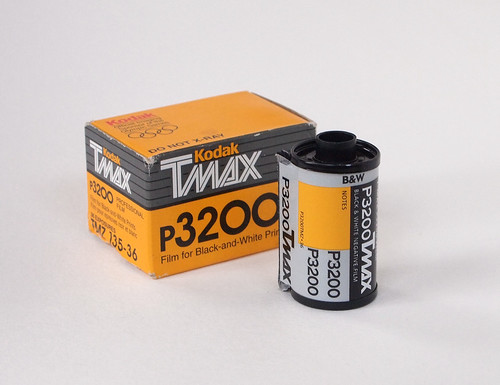 |
| Kodak T-Max P3200 |
Nearly three years ago I wrote a post about
Ilford Delta 3200, and at the time cited Kodak T-Max P3200 as being the other ultra-high speed film available, which was true at the time of writing. However in October 2012 Kodak announced, due to low demand, T-Max P3200 was being discontinued. [
Edit 23/2/18: Kodak have announced that T-Max P3200 is being re-introduced.] It would be interesting to see the relative volume of sales for Delta 3200 against T-Max P3200, but one advantage that Ilford's film always had over T-Max P3200 was its availability in medium format as well as 35mm. The two emulsions are similar: these are both tabular grain films with a true speed around 1000 ISO. As fast films tend to have a lower contrast range, and both have the latitude to be rated 3200 and provide acceptable results with this push. Incidentally, this would appear to be the reason for the 'P' in P3200, acknowledging the 'push' when used at the box speed of 3200. The reason for writing a blog post about Kodak T-Max P3200 now, rather than when it was announced that it was to be discontinued, was that I recently decided to shoot a couple of rolls I'd been storing in my fridge for some time; one roll had a develop before date of 2011, the other 2001. In my experience faster films lose more sensitivity with age: I usually buy a Ilford Delta 3200 as and when I need the film, rather than keeping rolls in storage.
Kodak T-Max P3200 (sometimes referred to as TMZ from its emulsion code) appeared on the market in 1988, and it took Ilford another ten years to respond with Delta 3200 (Fuji similarly released a Neopan 1600, also now discontinued). For some, the benefits of such a fast film are marginal: with the right development both Kodak and Ilford 400 speed films can be pushed 3 stops to 3200, and indeed Kodak's
discontinuation notice recommends using T-Max 400, pushed to 1600 as a replacement. However, for handheld night photography (for which I've often used Delta 3200), the increased contrast with push processing a slower film can be an issue as night scenes often tend to be high contrast in nature. The Kodak discontinuation notice admits this, stating that "The exception [to replacing P3200 with T-Max 400] would be extremely low light situations where P3200 might
be able to pull out some shadow detail that would otherwise be lost".
 |
| Kodak T-Max P3200, developed in ID11 stock solution, 12 minutes at 20º C. |
 |
| Kodak T-Max P3200, developed in ID11 stock solution, 12 minutes at 20º C. |
I first used T-Max P3200 in the mid-1990s, and in my post on Delta 3200 I wrote about the kind of subject that I often desired to photograph at the time, frequently the low light situations such a fast film was produced for. As Kodak T-Max P3200 was more expensive, I tended to use HP5 Plus, push processed to 800, 1600 or 3200 in these situations instead. Developed in ID11, P3200 yielded relatively smooth grain when exposed properly. For the two rolls of P3200 shot recently, I used Ilfotec LC29 developer; Rodinal (and latterly the R09 One Shot version) has been my film developer of choice for about seven years, but, as any developer, it's not ideal for all situations, especially with the fastest and most grainy films. The grain appears more prominent in the negatives developed with Ilfotec LC29 compared to ID11.
 |
Kodak T-Max P3200 (develop before date of October 2011),
developed in Ilfotec LC29, 1:19, 11 minutes at 20ºC. |
 |
Kodak T-Max P3200 (develop before date of September 2001),
developed in Ilfotec LC29, 1:19, 12m30s at 19ºC. |
Of the two rolls I've shot in the last couple of months, that with a "develop before" date of September 2001 had noticeable fogging when developed, leading to quite evident grain in the shadow areas; the film with a 2011 date provided better results, less fog, and appeared to give sharper negatives with a better tonal range. Although I hardly ever used Kodak T-Max P3200, it's always unfortunate when an emulsion disappears from the market, shrinking the range of available films, and many photographers will miss it (see the elegies below); Ilford Delta 3200 now remains as the only ultra-fast film.
Further reading:
Goodbye T-Max P3200 on the Online Photographer
The Demise Of Kodak TMAX P3200 John Vlahakis
Kodak P3200 T-MAX R.I.P. on Wallace Koopmans Artlog
Time To Start Hoarding: Kodak discontinues T-MAX P3200 film on Imaging Resource





No comments:
Post a Comment